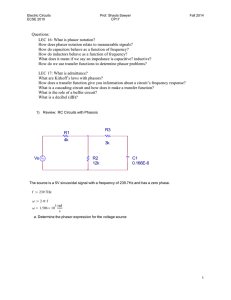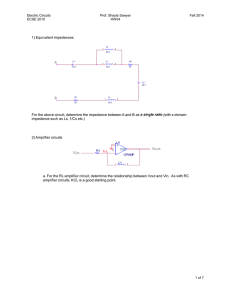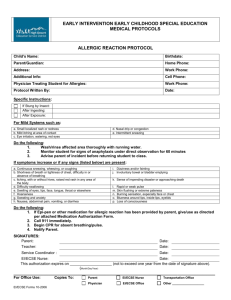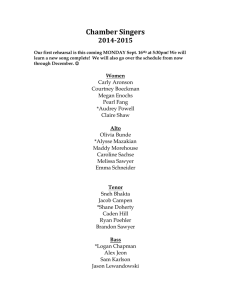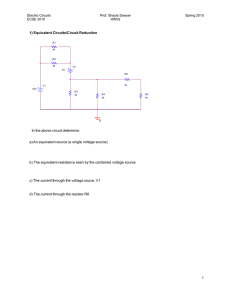Homework due: December 10, 2014 Grading: Pick part a or
advertisement
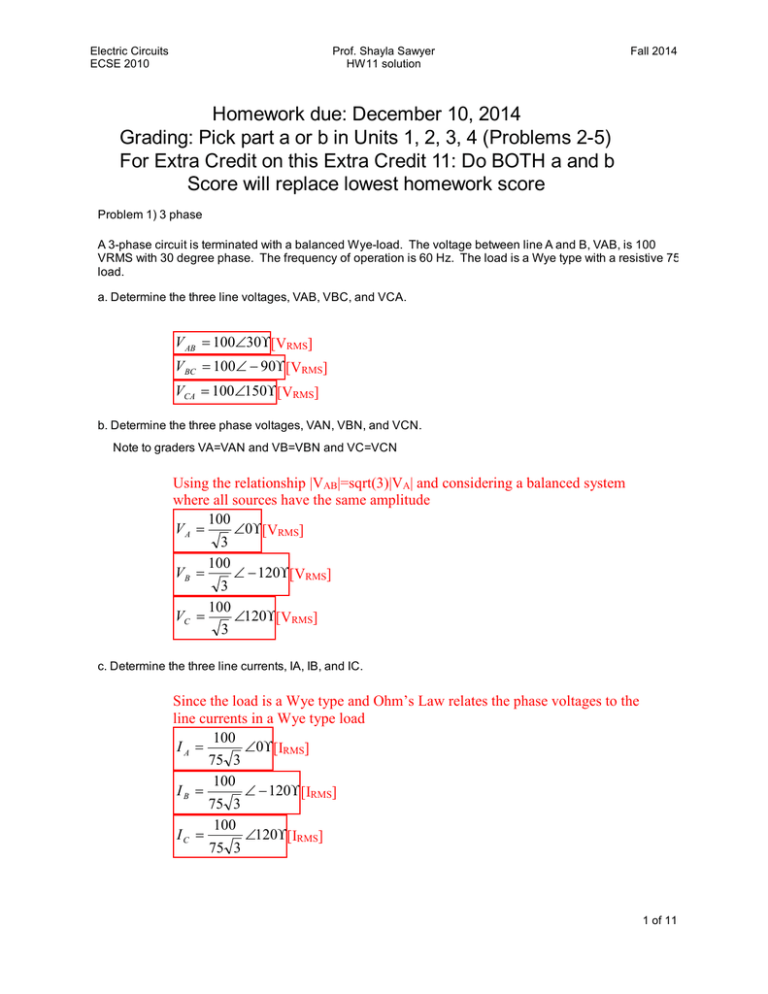
Electric Circuits ECSE 2010 Prof. Shayla Sawyer HW11 solution Fall 2014 Homework due: December 10, 2014 Grading: Pick part a or b in Units 1, 2, 3, 4 (Problems 2-5) For Extra Credit on this Extra Credit 11: Do BOTH a and b Score will replace lowest homework score Problem 1) 3 phase A 3-phase circuit is terminated with a balanced Wye-load. The voltage between line A and B, VAB, is 100 VRMS with 30 degree phase. The frequency of operation is 60 Hz. The load is a Wye type with a resistive 75Ω load. a. Determine the three line voltages, VAB, VBC, and VCA. V AB = 100∠30° [VRMS] V BC = 100∠ − 90° [VRMS] VCA = 100∠150° [VRMS] b. Determine the three phase voltages, VAN, VBN, and VCN. Note to graders VA=VAN and VB=VBN and VC=VCN Using the relationship |VAB|=sqrt(3)|VA| and considering a balanced system where all sources have the same amplitude 100 VA = ∠0° [VRMS] 3 100 VB = ∠ − 120° [VRMS] 3 100 VC = ∠120° [VRMS] 3 c. Determine the three line currents, IA, IB, and IC. Since the load is a Wye type and Ohm’s Law relates the phase voltages to the line currents in a Wye type load 100 IA = ∠0° [IRMS] 75 3 100 IB = ∠ − 120° [IRMS] 75 3 100 IC = ∠120° [IRMS] 75 3 1 of 11 Electric Circuits ECSE 2010 Prof. Shayla Sawyer HW11 solution Fall 2014 d. Determine the three phase currents, IAB, IBC, and ICA. For balanced loads, the delta configuration and Wye configuration are related by Z? = 3ZWye. Ohm’s Law relates the line voltage and phase current, giving 100 I AB = ∠30° [IRMS] 225 100 I BC = ∠ − 90° [IRMS] 225 100 I CA = ∠150° [IRMS] 225 e. Determine the power consumed through one of the loads. Since the Wye load and an equivalent Delta load must result in the same power 100 10000 * S = V ABRMS I AB = (100∠30° ) ∠ − 30° = [W], real power only RMS 225 225 f. If a 0.2 H inductor is added in series to the resistive load, which of the above currents and voltages will change? What is the new total power supplied? The voltages are determined by the source generators and are therefore unchanged. Changing the load results in a change of the currents. Both line currents and equivalent phase currents will change. ZWye = 75+j75.4 In one branch of the Wye circuit, the power is 10000 2 V ARMS 3 S= = = 22.1 + j 22.2 = 31.34∠45° [VA] * 75 − j 75.4 Z Wye 2 of 11 Electric Circuits ECSE 2010 Prof. Shayla Sawyer HW11 solution Fall 2014 Problem 2. Thevenin/Norton R1 2k R5 4k V2 2 R3 4 4k V1 R4 1k R2 2k I1 1E-3 RLoad a. Find the Thevenin equivalent circuit. VTH = 5.66 V RTH = 2.33k? IN = 2.43mA b. Dependent sources. R15 1k 2k 5V I1 4k 10 Vdc V3 0.001Vy V2 + Vy - 1k 0Vdc 2000(Ix) 2k a. Find the current through the 4k resistor. 3 of 11 Electric Circuits ECSE 2010 Prof. Shayla Sawyer HW11 solution 1 1 1 2k + 1k + 4k 1 − 4k 1 1 4k VA = -0.4545 VB = 4.091 Vy = VA Ix = -1.1mA 1 4k 1 1 1 + + 2k 4k 1k 0 1 − 4k − Fall 2014 − 2 V A 0 10 5 − 0.001 − 2 V B = 2k + 1k V −1 0 y 0 I 0 − 1 x 0 0.001 Problem 3) a. Differential equations R2 R1 1 L1 1E-3 Vs 2 C1 1E-6 1. Determine the differential relationship for the voltage across C1. d 2VC 1 R1 1 dVC1 1 R1 1 + + + + 1VC 1 = VS 2 dt L1C1 R 2 L1C1 L1 R 2C1 dt 2. Determine values for R1 and R2 so that the circuit is underdamped. For the circuit to be underdamped, we require α < ωo. Using the differential expression above and again rearranging some terms 1 R1 1 1 R1 + 1 + < 2 L R 2C1 LC R 2 Pick any two values that meet this requirement. R1 = 20, R2 = 50 satisfies the relationship 4 of 11 Electric Circuits ECSE 2010 Prof. Shayla Sawyer HW11 solution Fall 2014 3. For those values, plot the voltage across C1 if the source is 10V for t<0 and turns off at t=0. 10V 5V 0V -5V -10V 0s 0.1ms V(R2:1) 0.2ms 0.3ms 0.4ms 0.5ms 0.6ms 0.7ms 0.8ms 0.9ms 1.0ms Time b. Laplace Vs C2 U1 + 1 OUT - R3 1 C3 0.333 OPAMP R4 2 2.5 L2 0.5 1 0 + Vout - 0 The source voltage is 5 V for t < 0 and becomes 10 V for t > 0. 5 of 11 Electric Circuits ECSE 2010 Prof. Shayla Sawyer HW11 solution Fall 2014 1. Draw the s-equivalent circuit. 1/sC2 VC1(0-)/s=5/s U2 1/sC3 + 1 10/s VC2(0-)/s=0/s R4 OUT 0.333 - Vs OPAMP R3 1 2 2.5 + sL2 0.5 Vout 1 - 0 LI(0-)=0 0 2. Use circuit analysis and partial fraction expansion to find the voltage across the inductor for t>0. Vout = 2.5 exp(− 1t ) − 20 exp(− 2t ) + 22.5 exp(− 3t ) [V] Problem 4) a. Phasors R1 1k VOFF = 0 VAMPL = 10 FREQ = 1590 V1 R2 1 2 L2 5E-2 L1 2 2E-2 C1 1 1k 1. Determine a value for C1 so that the current through the source is 5mA and has zero phase. C1 = 5E-7 F 6 of 11 Electric Circuits ECSE 2010 Prof. Shayla Sawyer HW11 solution Fall 2014 b. Frequency response Vs C2 U1 + 1E-7 OUT - R3 1E5 C3 1E-5 OPAMP R4 U2 2 101 L3 1E-3 + OUT - C4 + 1E-9 OPAMP R5 Vout 1k 1 0 0 0 - 1. Sketch the Bode plots for the magnitude and phase, H(s)=Vout/Vin 7 of 11 Electric Circuits ECSE 2010 Prof. Shayla Sawyer HW11 solution Fall 2014 Problem 5) a. Transformers 1:2 R3 0.111 1:9 C1 1.074E-2 V1 1:2 FREQ = 60 VAMPL = 110 VOFF = 0 R2 8 1:5 R4 800 1:4 (top:bottom) R1 160 1. Determine the phasor form of the current through the source. IS = 3.0+j1.61 2. Determine the total power in the left branch, (R3 and C1) S = 98.3-j177 [VA] b. Power 8 of 11 Electric Circuits ECSE 2010 Prof. Shayla Sawyer HW11 solution Fall 2014 R6 75 VOFF = 0 VAMPL = 2kVrms FREQ = 60 V2 R5 50 R7 10 2 C2 1.06E-4 Zunknown L1 0.106 1 1. Determine Zunknown such that the power produced is purely real. 2. Determine the power produced in each load and the source Load 1: S = 80k Load 2: S = 48k-j16k Load 3: S = 23.5k+94.1k Load 4: S = -j78.1k Source: S = 151k Zunknown: -j51.2? 9 of 11 Electric Circuits ECSE 2010 Prof. Shayla Sawyer HW11 solution Fall 2014 10 of 11 Electric Circuits ECSE 2010 Prof. Shayla Sawyer HW11 solution Fall 2014 11 of 11
![[ACADEMIC] Mathcad - CP19.xmcd](http://s2.studylib.net/store/data/018312648_1-e7a2b28bf15168fb13c5c68e2ab5cea7-300x300.png)
